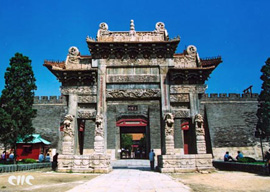 Located to the north of Tai'an City, the Dai Temple is the largest and most completed ancient building complex of Mount Taishan. It used to be the venue where emperors of the past dynasties held celebrations to worship heaven and earth and bestowed sacrifices to the God of the mountain. And it was also the first stop for the pilgrims on their way to the holy Mount Taishan.
Located to the north of Tai'an City, the Dai Temple is the largest and most completed ancient building complex of Mount Taishan. It used to be the venue where emperors of the past dynasties held celebrations to worship heaven and earth and bestowed sacrifices to the God of the mountain. And it was also the first stop for the pilgrims on their way to the holy Mount Taishan.
According to historical records, the original temple was first built during the Qin Dynasty (211BC ~ 206BC). Since the Han Dynasty (206BC ~ 220AD), people replicated the imperial palace to construct it. Several dynasties later pavilions, old cypresses and steles to the decoration were added, bringing the modern Dai Temple to what it is today.
Most of the present attractions inside the temple were left over from the Han Dynasty. Seen from a distance, a feel of grandiosity and magnificence appears in your mind. Take a closer view and you will feel astonished by its stateliness. It is the symbol of the Chinese feudality. Standing at the entrance to the temple, Yaocan Pavilion and the Archway of the Dai Temple will appear before your eyes first. Its grand framework and elaborate engravings impress tourists deeply and entice them to visit the temple. Entering it, there are many gateways and palaces, colorful and brilliant. Among them, the most conspicuous is the Hall of Celestial Gifts built in 1009 AD. This was during the Northern Song Dynasty, and one of the three palace-style architectures in China. Insidethe hall, there is a portrait of God, 4.4 m high, set in the middle. Around the walls of the east, west and north, an enormous mural 3 meters high and 62 meters long named "the God of Mountain Tai on an inspection tour" pictures the wonderful and grand scene of the inspection tour itself. Old cypress trees in the courtyard are very valuable. Five of them were planted by Emperor Wudi himself, from the Han Dynasty, and have lived for 2,000 years. Behind the temple is a bonsai garden. Different kinds of bonsais are offered for tourists? viewing pleasure.
Another attraction is the Bronze Pavilion. Lying in the northeast corner of the temple, the pavilion is made of bronze castings. Intricate workmanship makes it highly valuable, thus gaining its reputation as one of the famous bronze pavilions in China.
Ticket: 20 yuan (US$2.4)
Address: Northeast of Tai?an city zone, Shandong Province
Transportation: Take bus 1, 3 at Tai?an railway station.
(china.org.cn April 23, 2003)
|

